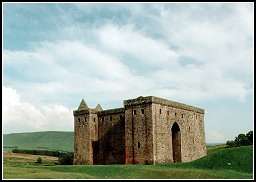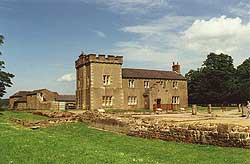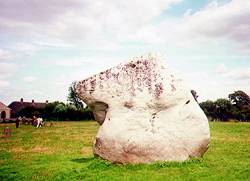Gretna
The name Gretna derives origins from ‘Gretenhow’, an Angle term meaning gravel hill. Of course the Angles were not the first settlers in Gretna, they had been preceded by both the Romans and Norsemen. The area surrounding Gretna has seen many battles between the English and Scots as they invaded each other. In 1376 Gretna was completely destroyed during one such battle. In 1542 at Solway Moss near Gretna Junction, 10,000 Scots were routed from the battlefield by the English. During the reign of Charles I (1625 – 1649) the border was redefined between England and Scotland, with the River Sark on the edge of Gretna being designated as the boundary line.
The Irregular Marriages
In 1754, just nine years after the failed Jacobite Rebellion was put to an end at Culloden, an Act of Parliament prohibited irregular marriages in England. The Bill was introduced by Lord Hardwicke as the result of an outcry against this form of wedding being performed at The Fleet Prison in London. Around the prison were sixty marriage houses and the names of about that many parsons are known but this is far from a complete list.
Irregular Marriages only required the couple to declare their acceptance of each other as husband and wife before two witnesses. This also generally included a written declaration of acceptance and some sort of certificate, although this was not always the case and some weddings had no written record of their occurrence. There are hundreds of pocket books held at Somerset House listing almost 200,000 weddings from these Fleet marriages. It is thought that in the early eighteenth century only half the marriages were carried out according to the laws of the Church. These weddings led to legal problems, especially where inheritance was involved with land owners having no control over the possibilities of their daughters marrying against their wishes. Lord Hardwicke outlawed them in England.
The English Marriage Act 1754 stipulated:
* Only weddings performed in a church and not verbal spousals should be legally recognised.
* All marriages carried out in a church should be recorded in the Parish Records and signed by the couple.
* All marriages that occurred in places or at times defined as illegal in the 1604 canons were declared invalid.
* Nobody could be married under the age of twenty-one without the consent of their parents or guardians.
* The laws were to be enforced by secular courts. Clergymen breaking these laws could be sentenced to fourteen years transportation.
This Act did not prohibit irregular marriages in Scotland however where the minimum age limit was still sixteen, therefore many young couples from England headed North for their weddings to take advantage of this. Irregular marriages continued to be held in Scotland until 1940. As Gretna was on the London – Edinburgh stagecoach route and was the first stopping point across the border, many couples decided to be married there, as it was the earliest opportunity to do so. Many of the buildings the couples were married in tended to be those at which the stagecoaches stopped.
 During the eighteenth century Gretna Green was little more than a collection of white washed cottages, a few farms and a church. The Maxwell Arms and the Queens Head, often referred to as the Marriage House were the first two hostelries over the border and played host to many of the early weddings. In 1791 when local boundaries changed they fell squarely in Springfield, not Gretna, therefore many of the marriages associated with Gretna actually occurred in Springfield. When the bridge over the River Sark was built, many coaches bypassed Springfield and Gretna became more popular. The Old Toll Bar based at the bridge started to hold wedding ceremonies and Gretna Hall built in 1710 was changed into a hotel which also profited from the marriage business. There were two other inns in Gretna that held weddings and several private homes. Three of the old wedding venues are still in use today, these being the Old Toll Bar, Gretna Hall and the Old Blacksmiths Shop in Gretna Green.
During the eighteenth century Gretna Green was little more than a collection of white washed cottages, a few farms and a church. The Maxwell Arms and the Queens Head, often referred to as the Marriage House were the first two hostelries over the border and played host to many of the early weddings. In 1791 when local boundaries changed they fell squarely in Springfield, not Gretna, therefore many of the marriages associated with Gretna actually occurred in Springfield. When the bridge over the River Sark was built, many coaches bypassed Springfield and Gretna became more popular. The Old Toll Bar based at the bridge started to hold wedding ceremonies and Gretna Hall built in 1710 was changed into a hotel which also profited from the marriage business. There were two other inns in Gretna that held weddings and several private homes. Three of the old wedding venues are still in use today, these being the Old Toll Bar, Gretna Hall and the Old Blacksmiths Shop in Gretna Green.
Although evidence suggests runaway couples were crossing the border to be married in Gretna as early as 1734, it was the 1754 Act which made the practice popular. The runaway marriage trade brought opportunities for people to set themselves up as ‘priests’. These people came from many diverse backgrounds including soldiers, fishermen, smugglers, cobblers, stonemasons, valets, pipers, pedlars and labourers, none of them being ordained Ministers of the Church. Gretna had the infrastructure to deal with the incoming tide of weddings and it said that a couple could arrive in Gretna at any time, day or night and be married within five minutes without sending any prior warning of there arrival.
As the marriage industry was effectively an easy way to make money, many varied characters became Gretna ‘priests’. One of the first was Auld Watty Coulthard, a smuggler by trade who used to hold ceremonies on the beach amongst other places. Joseph Pasley (Paisley) worked for Watty smuggling when he wasn’t fishing. One day whilst Auld Watty was dealing with some contraband outside the Gretna area, he left Joseph to perform one of his marriage ceremonies for him. This was the first of many, as when Joseph discovered how easy and financially lucrative the business was he set himself up as a ‘priest ‘ and became one the most notable ones.
Gretna Green SignBorn in 1730, Joseph was a large rough man who was able to bend metal pokers over his bare arm and straighten horseshoes with his bare hands. He was also known as being a hardened drinker, having 2¼ pints of brandy every day for the last forty years of his life. In a two day drinking session he finished a gallon cask of cognac with a friend, before they kicked the barrel to pieces, angry that it was empty. Joseph was not sure of the legality of the Gretna weddings to start with and used fields and back alleys to reach the marriage rooms. He also used to write the certificates as poorly as possible to disguise his hand writing and use a false name. When called to court in London to verify that he witnessed a certain couple’s marriage he consulted a barrister and was shocked to discover that the weddings were legal and he had nothing to fear as long as he stopped using false names. From this time on he would dress smart and walk the main streets when going to a wedding. One day whilst doing a double ceremony he ended up marrying the wrong couples together and then just left them to sort it out by themselves. He died in 1814, being twenty-five stone. It is believed that whilst on his death bed he heard the coach come in and three couples alight eager to be married. He got off his death bed, married the couples and lay back down £300 richer.
George Gordon, another early Gretna ‘priest’ used to lie quite openly, claiming that he paid the Government £50 a year for a special license to conduct marriage ceremonies. Being an ex-soldier, George would wear his red dress uniform with a large cocked hat and high jack boots. He would also wear a large sword on his belt.
‘Bishop Lang’, was so called because he would wear the robes of a Priest. David Lang (his proper name) probably had one of the most adventurous lives of any of the Gretna ‘priests’. Born in 1755 he was a relative of Joseph Paisley who served many years in the Royal Navy after being press-ganged in Lancashire. He and his ship were captured by John Paul Jones whom the British regarded as a pirate, but the Americans saw him as the father of their Navy. David served on an American ship during the American War of Independence. He came to Gretna after jumping ship and soon recognised the lucrative marriage industry as being the source of a profitable future.
The Three Week Cooling Off Period
Lord Broughams’ Bill introduced in 1857 became known as ‘the three week cooling off period’. The Marriage Act 1857 brought restrictions on marriage in Scotland and curtailed Gretna’s lucrative trade of the last hundred years of profiting from it. The Toll Bar alone had held over eight thousand weddings between 1843 and 1856. The Bill stipulated that at least one party of the marrying couple would have to reside in Scotland for a minimum of twenty one days prior to the proposed marriage.
The Act drastically reduced the amount of weddings for over forty years, then it became popular to be married in Gretna again and the irregular marriages continued although with much lower figures until 1940 when they stopped throughout Scotland. Before the irregular marriages ceased, Richard Rennison, the best known of this periods Anvil Priests claimed to have solemnised 5147 marriages in his thirteen year career.
The new law required the couples to give notice of their intended marriage and the ceremony could only be solemnised by a Minister of Religion or an authorised Registrar. The minimum age of marriage remained at sixteen which still set Scotland apart from England.
The Law changed again in 1977, enabling marriages to be held in Scotland without any residential qualification, therefore removing Lord Broughams’ cooling off period. This new Act stated that parties must give written notice of their intention to marry no less than 14 days before the date of their marriage.
Gretna Today
The township of Gretna familiar to today’s visitors dates back to 1915. The town was the first new town to be Government sponsored and the major industry in the area was munitions, with a specially built cordite factory. The new Gretna was deemed a social experiment under the guidance of David Lloyd George (Minister of Munitions) and Raymond Unwin, attributed as being the man behind the huge housing drive in the 1920’s. Gretna was designed to house a contained community, along with its own Hospital, School, shops, Police Station, Fire Service, halls, clubs and laundry. The churches were given individual designs and provided by the Ministry of Munitions. The Roman Catholic Church is in the Italian Renaissance style, the Church of Scotland building was also in an Italian style but with red tiles and rough walls, whereas the Scottish Episcopal Church was designed along the lines of Gothic architecture.
Civil marriages prior to 1991 were conducted in an office on shared premises with the local rent office and dentist. This small office could not cope with the amount of requested civil ceremonies and many couples were re-directed to other venues throughout the district. The current Registration Office on Central Avenue was opened on 2 September 1991 by Pat Bryden MBE, who upon retiring from being the Registrar for Gretna had solemnized over ten thousand marriage ceremonies. This new building was designed by Peter Nelson and his team from Architectural Services, Dumfries and Galloway Council, after winning an in-house design competition. His inspiration came from oriental concepts and the work of Charles Rennie Mackintosh. An extension to the building costing £200,000 was opened on 9 February 1998 by Councillor Alan Mackay and was again designed by Peter Nelson.
The Post 1977 Weddings
The popularity of Gretna has increased throughout the past twenty years, making the Registration Office the busiest in Great Britain and probably Europe. Only twenty percent of Gretna’s weddings are for Scottish couples, with sixty percent coming over the border from England and Wales. Given the easy access to Dumfries and Galloway from Ireland through Stranraer it is not surprising that ten percent of the marriages come from across the Irish Sea, but a surprising five percent originate from Germany. The remaining five percent of the weddings held in Gretna are of foreign nationals from countries not already mentioned and who have travelled from all over the world to be married in this little border town.




Re: Gretna
I LIVE THERE! I only joined today and My town is featured!
Re: Gretna
Hi Leekduck, I work there!!
Re: Gretna
Wow thats coinicidental!